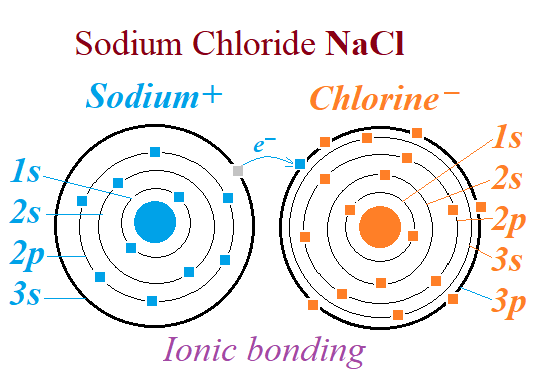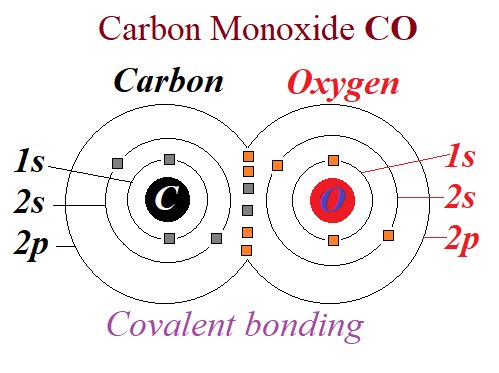Valence Electrons
Previous lecture was about chemical reaction between elements - bonding between atoms that does not affect their nuclei.
We have seen that the most important role in these reactions is played by electrons in the outer most shell of an atom.
In particular, chemical reactions are expected between elements that have incomplete outer subshells, but complementary to each other to form complete subshells by either borrowing electrons from each other, forming electrovalent or ionic bonding between positively and negatively charged ions or sharing electrons, forming a covalent bonding between atoms.
Recall the chemical bonding between atoms of sodium and chlorine.
Sodium has atomic number 11, and its electrons are arranged as
Na: 1s2 2s2 2p6 3s1
Chlorine has atomic number 17, and its electrons are arranged as
Cl: 1s2 2s2 2p6 3s2 3p5
The mechanism of bonding can be represented in such a case as follows.
1. Sodium atom releases the only electron from the subshell 3s, becoming a positive ion
Na → Na+ + e−
2. Chlorine atom captures this electron in its subshell 3p, becoming negative ion
Cl + e− → Cl−
3. Now all subshells are filled to capacity and both atoms are electrically charged with opposite charges, which makes them stick to each other, forming a molecule of salt.

That was a typical example of electrovalent or ionic bonding.
Valence electrons are those exact electrons that are capable of participating in bonding with other electrons of other atoms.
In most cases they belong to the outer electronic shell of an atom.
Elements with electron structure ending in 1 electron in the outer subshell s, like sodium (Na), have that 1 electron as the only valence electron. The valency of such elements is 1. Atoms of these elements often bond by giving away this electron to complete other atom's outer subshell, like ionic bonding with chlorine (Cl) that needs exactly one electron to complete its outer p subshell. The valency of the counterpart atom in such a case is also 1.
The structure of a molecule that results in bonding of these two atoms can be symbolically expressed as
Na−Cl
where a single bar between symbols of elements corresponds to the valency of each.
Considering this is an ionic bonding, we might as well use more precise symbolics
Na+−Cl−
Elements with electron structure ending in 2 electrons in the outer subshell s, like barium (Ba), have these 2 electrons as the only valence electrons. Atoms of these elements often bond by giving away both of these electrons to complete other atom's outer subshell, like ionic bonding with two atoms of chlorine (Cl), each of which needs one electron to complete its outer p subshell, forming a molecule BaCl2.
The structure of a molecule that results in bonding of these three atoms can be symbolically expressed as
Cl−Ba−Cl
where bars correspond to the valency of each atom, 2 for barium and 1 for chlorine.
This process can be described as follows.
1. Barium atom (atomic number 56) frees two electrons from the outer subshell 6s, becoming a positive ion
Ba → Ba2+ + 2e−
2. Two chlorine atoms capture one electron each in their outer subshell 3p, becoming negative ions
2Cl + 2e− → 2Cl−
3. Now all subshells are filled to capacity and three atoms are electrically charged. One atom of barium is positive, two atoms of chlorine are negative, which makes these two atoms of chorine stick to an atom of barium, forming a molecule of barium chloride BaCl2.
So, more precise representation of this molecule would be
Cl−−Ba+−Cl−
Let's consider a more complicated case of forming aluminum oxide - a molecule combining atoms of aluminum (Al) and oxygen (O).
The configuration of 13 electrons in the atom of aluminum is:
Al: 1s2 2s2 2p6 3s2 3p1
The configuration of 8 electrons in the atom of oxygen is:
O: 1s2 2s2 2p4
As we see, aluminum has one valence electron in subshell 3p. If it loses this electron, its 3rd subshell would still have two electrons in subshell 3s. While technically complete, it's still exposed to be captured by some other atom.
So, an atom of aluminum can lose either (only under special conditions) 1 electron, the 3p1, or (under normal conditions) 3 electrons, the 3p1 and 3s2.
The valency of aluminum is, therefore, either 1 (only under special conditions) or, typically, 3.
A possible molecular bonding between 2 atoms of aluminum and 1 atom of oxygen Al2O that can be established in special laboratory conditions would look like this:
Al−O−Al
This is a very unstable molecule because the 3rd shell of the atom of aluminum with only one remaining subshell 3s and two electrons in it still remains exposed.
Much more stable molecule is formed, when 2 atoms of aluminum contribute 6 electrons (3 electrons from each atom, emptying subshells 3s and 3p) and 3 atoms of oxygen capture them (2 electrons are captured by each oxygen atom to fill its 2p subshell). The formula of this aluminum oxide molecule is Al2O3 with the structure that can be pictured as
O=Al−O−Al=O
where bars correspond to the valency of each atom, 3 for aluminum and 2 for oxygen.
From the position of an exchange of electrons this can be represented as follows.
1. Two aluminum atoms free 3 electrons each from their outer shell #3 (1 electron from subshell 3p and 2 electrons from subshell 3s), becoming positive ions
2Al → 2Al3+ + 6e−
2. Three oxygen atoms capture 2 electrons each in their outer subshell 2p, becoming negative ions
3O + 6e− → 3O2−
3. Now all subshells are filled to capacity and all 5 atoms are electrically charged. Two atoms of aluminum are positive, three atoms of oxygen are negative, which makes these three atoms of oxygen stick to two atoms of aluminum, forming a molecule of aluminum oxide Al2O3.
The atoms in this molecule are bonded ionically, so we can represent the molecule's structure as
O2−=Al3+−O2−−Al3+=O2−
As you saw from the previous example, in some cases the valency of an atom can be different under different circumstances. While for a bonding between aluminum and oxygen only one stable configuration is observed, in other cases more than one configuration occurs under normal conditions.
The common property of the examples above is that we analyzed the molecules comprised of a metal and non-metal.
Metals have their outer electrons relatively easier departing from their nuclei, that's why in all cases above the bonding between a metal and non-metal was ionic, when metals gave their electrons to non-metals.
As a final example, consider the formation of a molecule of carbon monoxide CO.
The electron configuration of carbon (atomic number 6) is
C: 1s2 2s2 2p2
The configuration of 8 electrons in the atom of oxygen, as we already discussed, is:
O: 1s2 2s2 2p4
None of the elements in a molecule of carbon monoxide is a metal, so their electrons are not capable, ready and willing to depart from the their nuclei, as in metals. As a result, the electrons are not transferred from atom to atom forming ions, but are shared between the atoms to form a covalent bonding.
Two electrons from 2p subshell of carbon and four electrons from 2p subshell of oxygen, totaling 6 electrons (exactly the maximum number for 2p subshell), become a common property of both atoms, completing their corresponding outer subshells 2p.

The act of sharing electrons between atoms of carbon and oxygen is the glue holding the molecule together in covalent bonding.


No comments:
Post a Comment